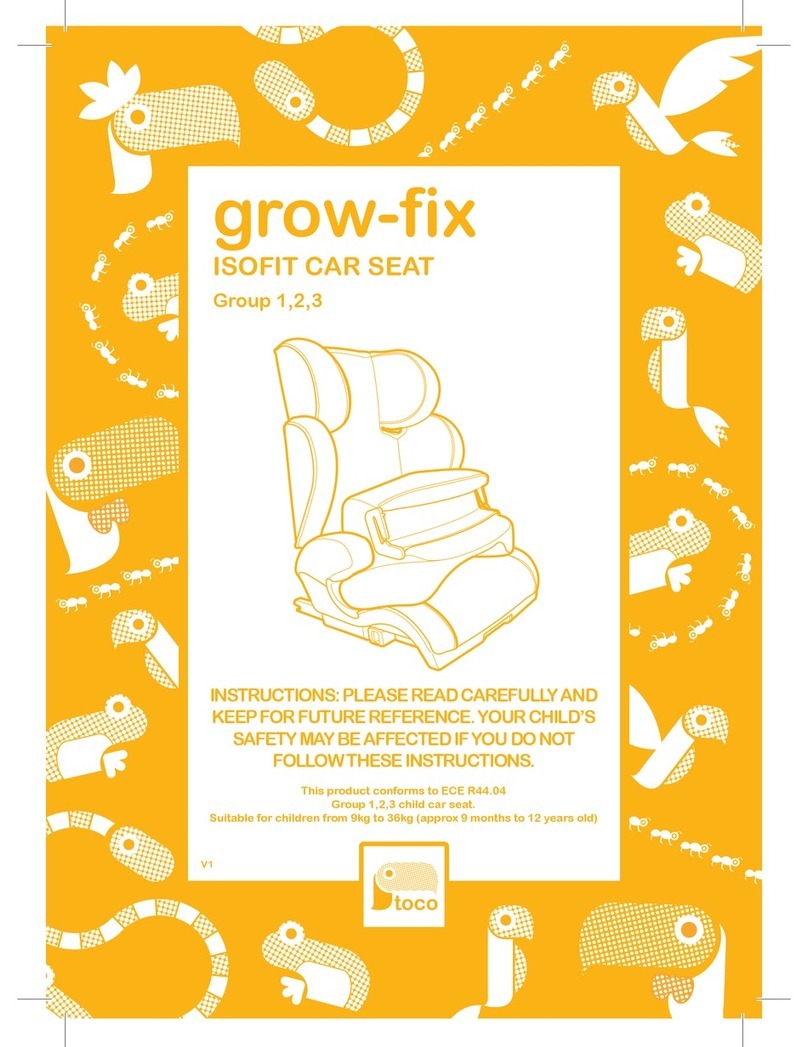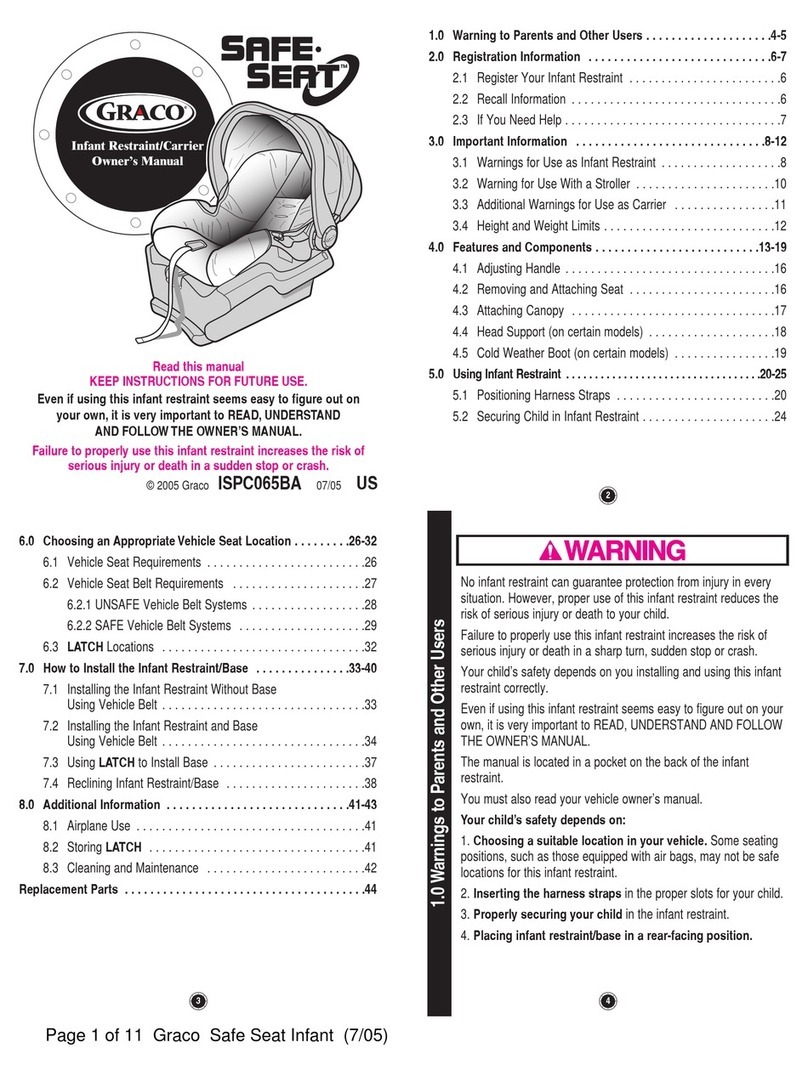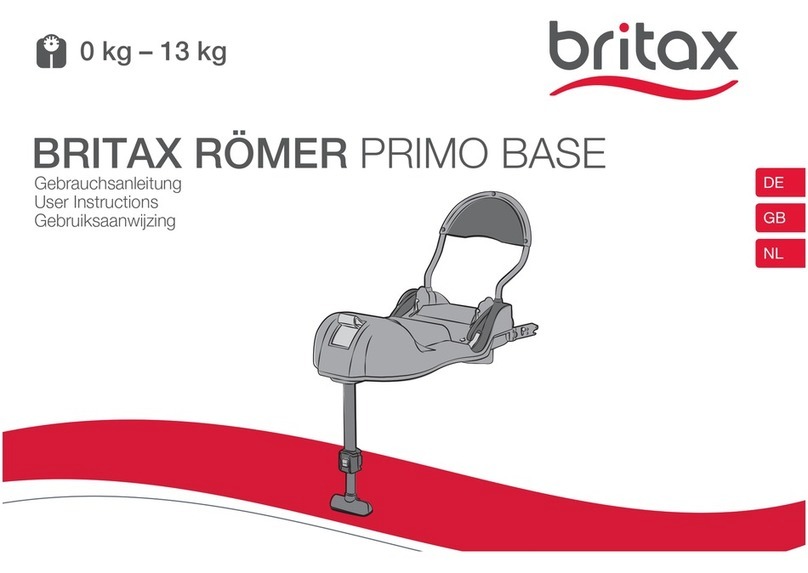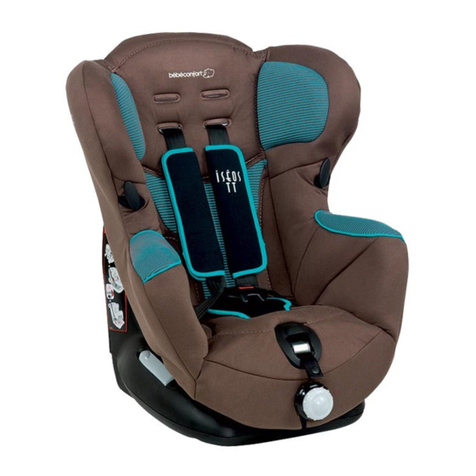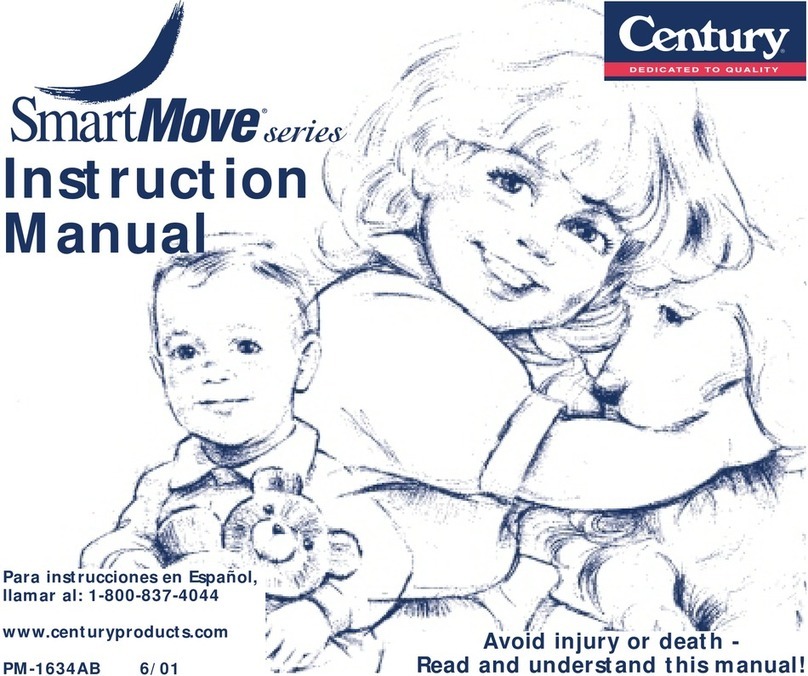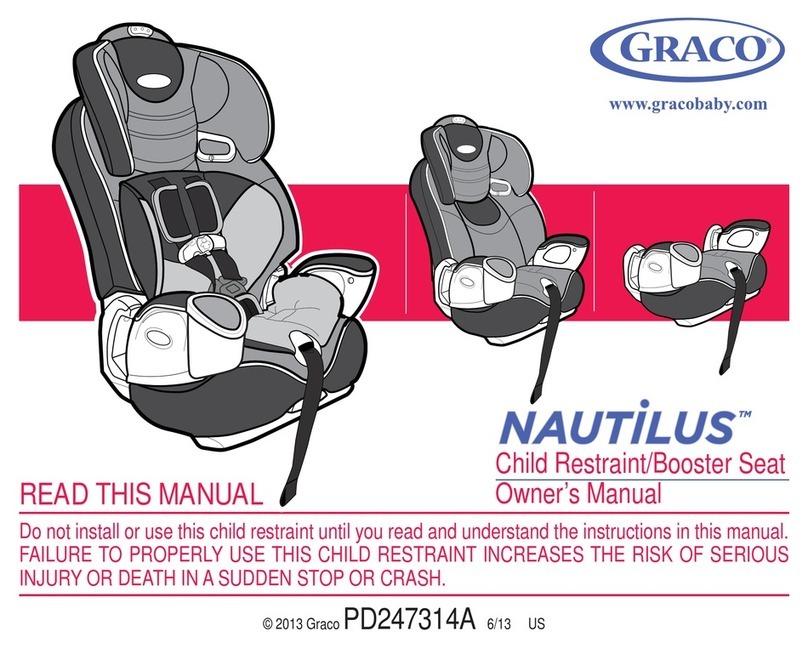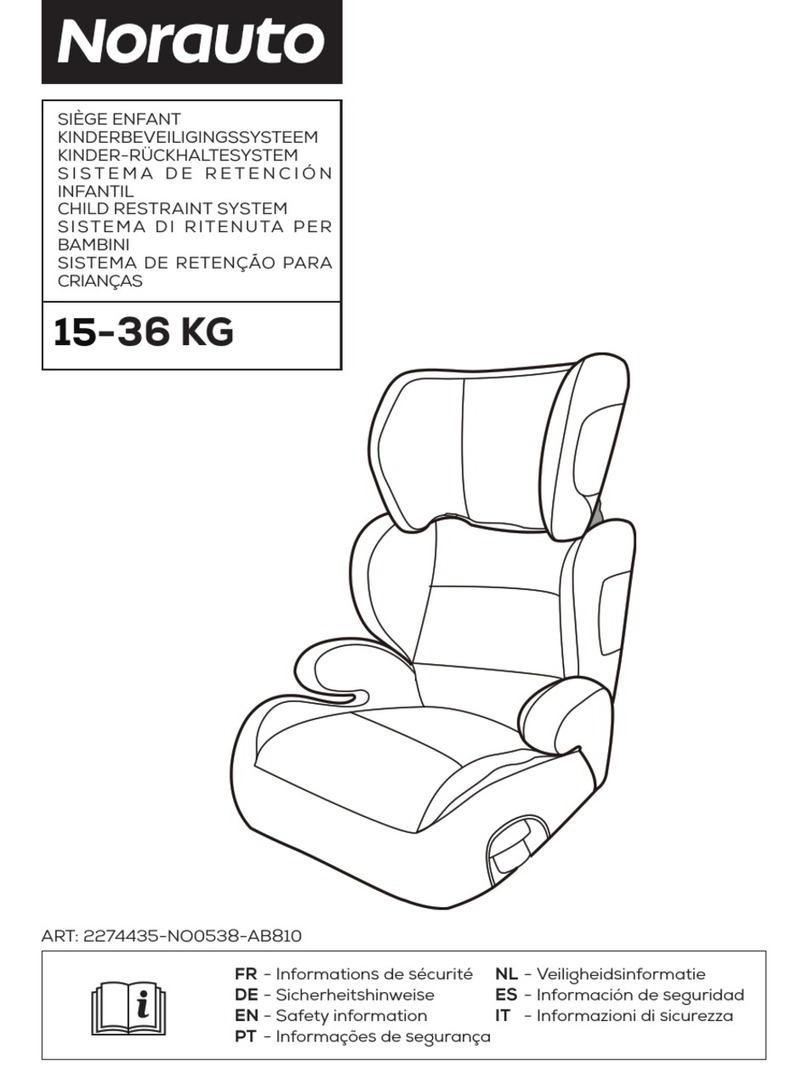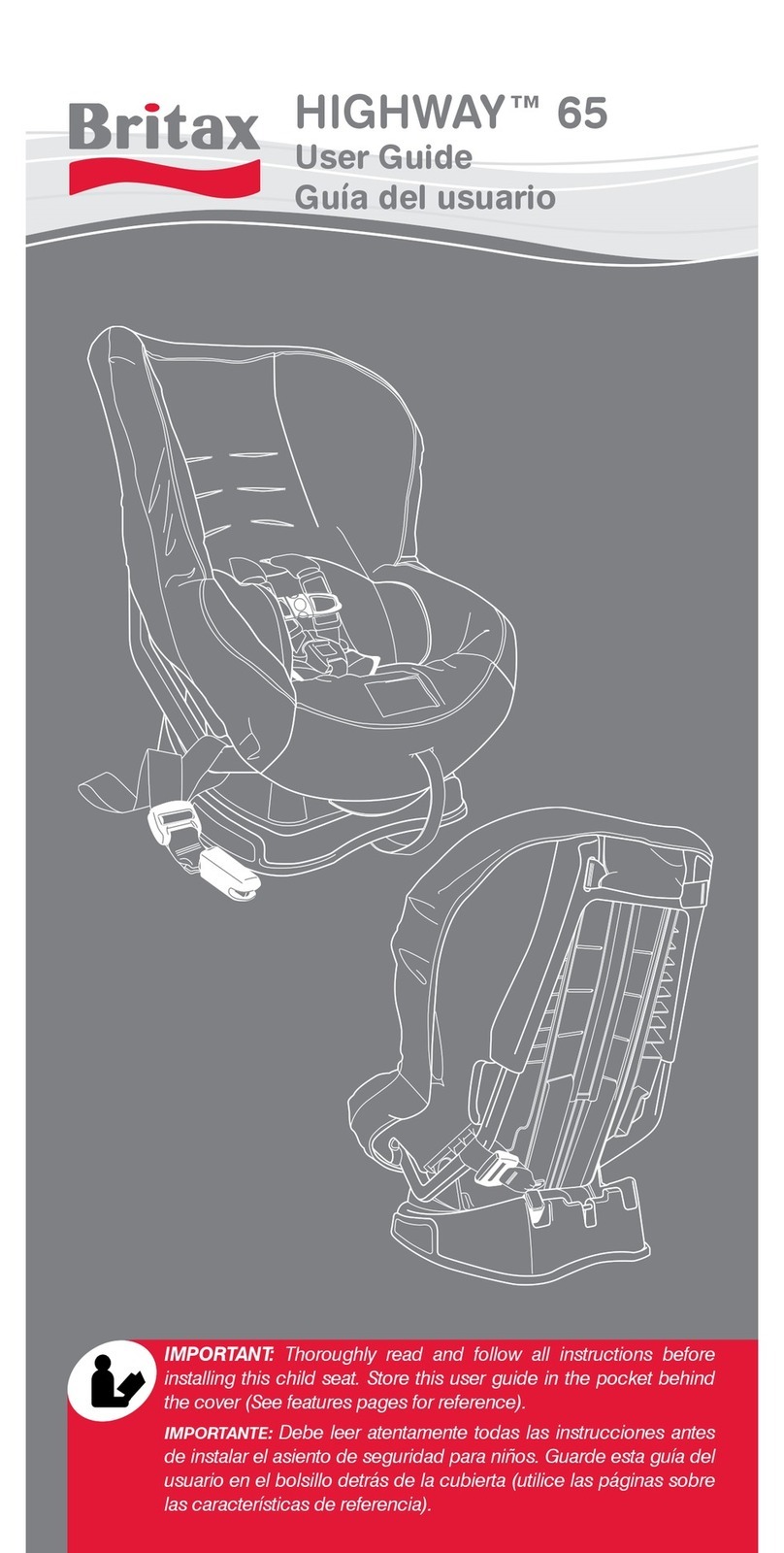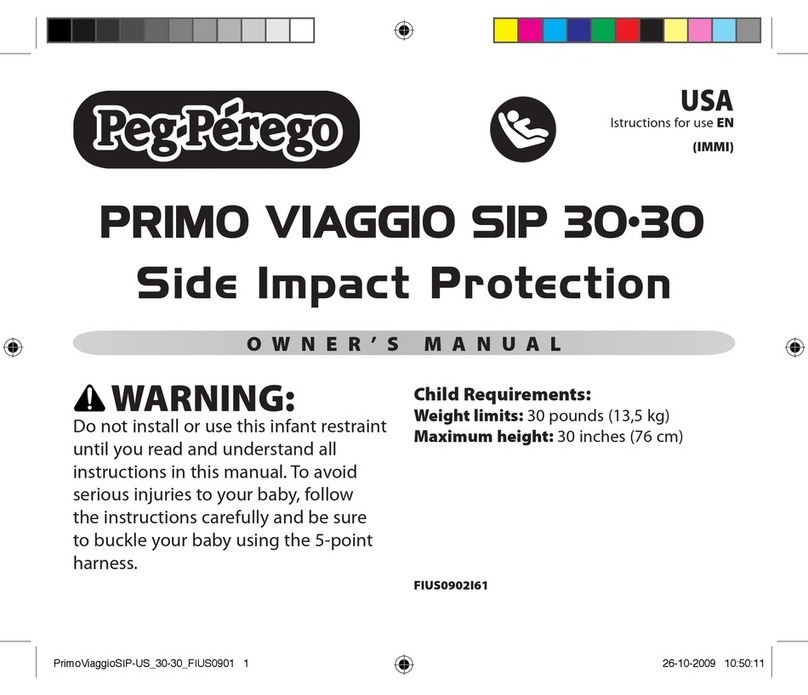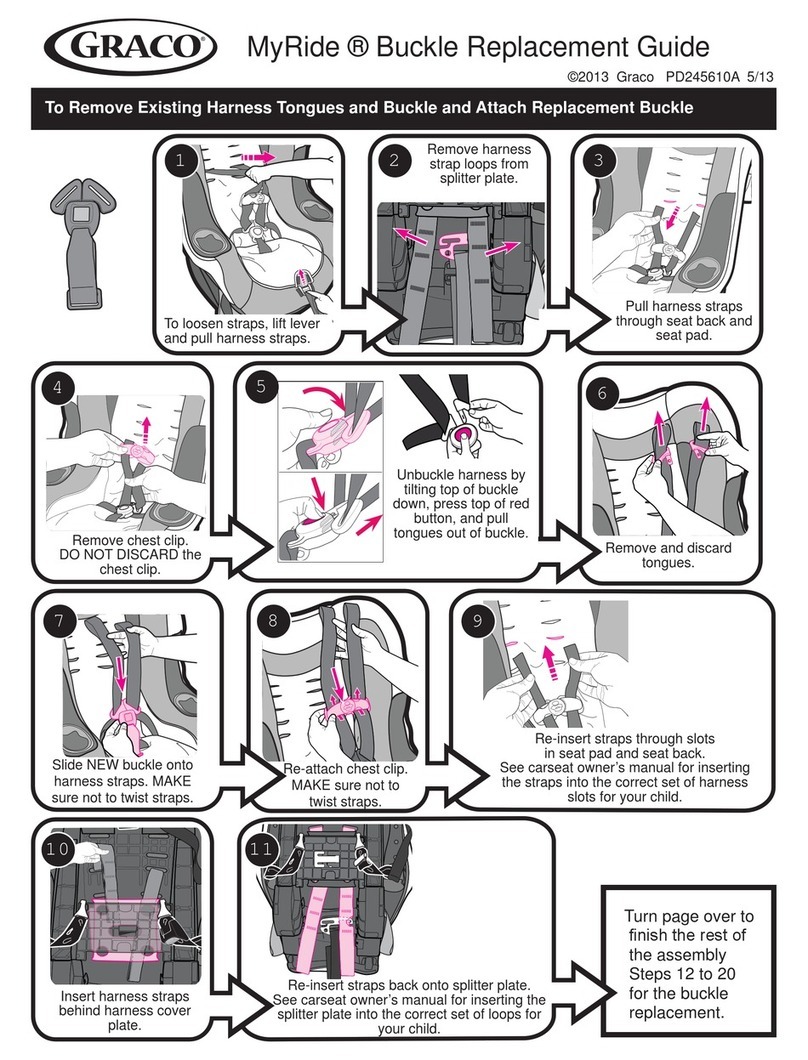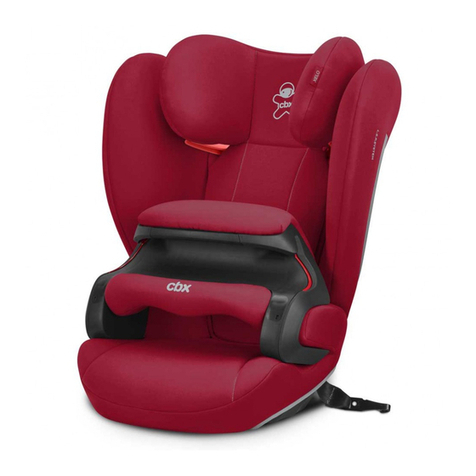Toco Looka User manual

This product conforms to ECE R44.04
Group 1,2,3 child car seat.
Suitable for children from 9kg to 36kg (approx 9 months to 12 years old)
ISOFIX CAR SEAT (with top tether)
INSTRUCTIONS: PLEASE READ CAREFULLY AND
KEEP FOR FUTURE REFERENCE. YOUR CHILD’S
SAFETY MAY BE AFFECTED IF YOU DO NOT
FOLLOW THESE INSTRUCTIONS.
looka
Group 1,2,3
V2

2
Contents
Welcome
Your 3 year warranty
Thank you for purchasing the Toco Looka Group 1,2,3 Car Seat.
Please read these instructions carefully before use to ensure safe and satisfactory operation of
this product.
Your child’s safety is your responsibility.
This seat can either be fitted using the ISOFIX system (also known as ISOFIX) in conjunction
with the vehicle’s 3-point safety belt or by just using just a standard 3-point vehicle seat belt. It
is advised that if your vehicle has ISOFIX anchor points then the seat should be fitted using the
ISOFIX system.
Whilst we make and test our products to the highest standards of durability there’s always a
small chance of a hiccup! Our promise is to repair, replace or refund a Toco product that has
an identified manufacturing defect from the date of purchase for a full 3 years thereafter at no
extra cost.
However, you must register within 28 days of the date of purchase to receive the full 3 years
guarantee!
To receive your full guarantee you can register your product by:
visiting www.tocobaby.co.uk/warranty.html and complete the warranty form,
or by telephone on 0161 335 2508.
Welcome 2
Your 3 year warranty 2
Safety information 3-5
Parts Checklist 6
Care & maintenance 19
Positioning the car seat 7-8
Adjusting the headrest/harness height 8
Fitting the car seat using the ISOFIX system 9-10
Removing the ISOFIX fitted car seat 11
Placing your child in the seat - group 1 [9-18kg] 11-12
Removing the 5-point harness 13-14
Replacing the 5-point harness 15-16
Placing your child in the seat - groups 2,3 [15-36kg] 17
Removing and replacing the seat covers 18

3
Contents Safety
1. This child car seat is approved for three different types of fitting:
a) “Universal ISOFIX” for use as a group 1 [9-18kg] car seat locked onto the vehicle’s ISOFIX
anchor points in conjunction with the car seat’s integral 5-point harness.
b) “Semi-Universal” with connectors locked onto the vehicle’s ISOFIX anchor points, used in
conjunction with the vehicle’s 3-point safety belt.
c) “Universal” for use with just the vehicle’s 3-point safety belt.
2. This is a “Universal” child restraint for groups 2,3 [15-36kg]. It is approved to ECE R44.04
For general use in vehicles and will fit most, but not all, car seats.
3. A correct fit is likely if the vehicle manufacturer has declared in the vehicle handbook that
the vehicle is capable of accepting a Universal child restraint for the stated age group.
4. This child restraint has been classified as UNIVERSAL under more stringent conditions
than those which applied to earlier designs which do not carry this notice.
5. If in doubt, consult either the manufacturer or the retailer.
6. Only suitable if the approved vehicles are fitted with 3-point/static/retracting seat belts
which are approved to ECE R16 or equivalent.
7. This is an ISOFIX CHILD RESTRAINT SYSTEM. It is approved to ECE R44.04 for general
use in vehicles fitted with ISOFIX anchorage systems.
8. It will fit vehicles with position approved ISOFIX attachment points (consult the vehicle
handbook), depending upon the category of the child seat and of the ISOFIX fixture position.
9. The mass Group and the ISOFIX weight range for which this device is intended is: Group 1
9-18kg, ISOFIX size class B1
NOTICES
Read carefully before attempting to fit the child car seat
WARNING: NEVER leave your child unattended – your child’s safety is your responsibility.
WARNING: The child car seat must be fitted in accordance with the manufacturer’s instructions.
Incorrect installation could be dangerous.
WARNING: This installation must only be performed by a competent adult. Don’t try to install the
seat when intoxicated or drowsy.
WARNING: Always ensure that new or occasional users [e.g. Grandparents] have read the
instructions or been taught the correct installation by someone who has read and understood
the instructions.
WARNING: Always keep this instruction manual with the child car seat, or in the vehicle in which
you are carrying the child car seat. Some models of child car seat have a pocket to store the
instructions.
Getting started
Before starting
WARNING: Do not fit the child car seat on a side or rear facing vehicle seat.
WARNING: Before installing the child car seat ensure that the passenger seat you are using is
locked in the upright position.
WARNING: Do not use the child car seat in the home - it has only been designed to be used in
the car.
WARNING: Do not leave loose/unsecured objects on the back seat of your car or the parcel
shelf. They may be dangerous to your child if you are forced to brake suddenly.

4
WARNING: Make sure that the child car seat is placed somewhere so that rigid items and plastic
parts do not become trapped in doors or movable seat units when the seat is in everyday use.
WARNING: Always use the vehicle’s door child safety lock system, if one is available, to make it
impossible for the child to open the car doors from inside.
WARNING: Allow the child a break during long car journeys and make sure they don’t get out of
the car unaided and without supervision.
WARNING: The child car seat must be fitted securely to the passenger seat. Ensure that it is not
loose or wobbly after you have fitted it. If it is loose, re-fit it.
WARNING: The child car seat must not be used without its original cover. The original cover is
essential for the safe operation of the child car seat.
WARNING: Stop the car at regular intervals to check that the child car seat is in the correct
position and that both the car seatbelt (if used) AND the child car seat harness are still taut and
latched.
WARNING: Ensure that no part of the child car seat is trapped in a door or folding seat.
WARNING: In the event of an emergency it is important to be able to release the child quickly (as
defined by British Standards). This means that the seat buckle cannot be fully tamper proof and
you should actively discourage your child from playing with or using the buckle.
WARNING: If you travel with passengers using both the front and the rear passenger seats, the
lighter occupants should be in the rear and the heavier occupants in the front.
WARNING: If you have no option other than to put your child car seat on a rear passenger seat
next to side airbags:
- Consult with your vehicle manufacturer for side airbag details. It may not be safe.
- Make sure your child does not lean into the area immediately around the airbag.
WARNING: Do not place anything under the child car seat (e.g. A towel or cushion) as this could
affect the performance of the seat in an accident.
WARNING: Avoid winter clothing bundling - bulky clothing can lead to incorrect harness
tightening. In an accident, the child can slip right out of the extra padding - and thus out of the
seat. Let the car warm up or cool down prior to placing your child in there if possible. If your
child is cold, place a blanket over the top of the harness.
If your centre rear passenger seat is fitted with a three point seatbelt system then you should
use it.
If your centre rear passenger seat does not have a three point seatbelt system (i.e. No seatbelt
at all, or only a lap belt)
- Then you should use the rear left passenger seat or the rear right passenger seat.
The front passenger seat can only be used if it DOES NOT have an airbag and IS fitted with a
three point seatbelt system.
EXTREME HAZARD
NEVER USE IN FRONT PASSENGER SEATS EQUIPPED WITH
AIRBAGS (SRS). THIS CAN INCLUDE REAR PASSENGER SEATS
THAT ARE EQUIPPED WITH AIRBAGS*
*Consult car manufacturer for suitability. Children’s bodies are not able to
withstand the forces exerted on them by a deploying air-bag
Which is the safest passenger seat for the child seat?
When using the child car seat

5
Seatbelt
Sunlight/hot days
WARNING: Never use any load bearing contact points other than those described in these
instructions or marked on the child car seat.
WARNING: Ensure that the lap section of the harness is worn low down, so that the pelvis is
firmly engaged.
WARNING: Make sure that ALL the passengers in your vehicle have their seatbelts fastened, as
unrestrained people can be very dangerous to the child in an accident.
WARNING: NEVER use a seatbelt routing scheme that differs from these instructions.
WARNING: The harness must be used at all times when your child is in the child car seat.
WARNING: If you are installing the child car seat using a seatbelt ensure there are no twists in
the seatbelt.
WARNING: Don’t leave your child in the child car seat while parked in direct sunlight or on a hot
day.
WARNING: Do not subject the child car seat to prolonged direct sunlight as this may be
dangerous for your child (the metal and plastic fittings could become hot) and may cause the
fabric to fade. You can reduce this problem by covering the child car seat with a sheet when not
in use.
WARNING: Ensure that the child car seat is as close as possible to the backrest of the car seat.
WARNING: REMOVE the headrest of the passenger seat being used if it obstructs the proper
installation of the child car seat. REMEMBER to refit the headrest when the child car seat has
been removed.
Back of the seat/headrest
WARNING: NEVER buy a second hand child car seat. It may have unseen damage.
WARNING: The manufacturer only guarantees this product when the original owner uses it.
WARNING: You MUST replace the child car seat and your vehicles seatbelts if they becomes
badly worn or damaged.
WARNING: You MUST replace the child car seat if it is involved in an accident – it may have
unseen damage and may not protect your child as well as they should.
Second hand or damaged child car seats and seatbelts

6
Parts checklist
1Shoulder straps 7Insert cushion
2Shoulder pads 8Harness buckle
3Top tether hook 9Shoulder belt guides
4ISOFIX arms 10 Headrest
5Harness adjuster strap 11 Headrest adjuster handle
6Harness adjuster button 12 Top tether mechanism
1
3
5
6
7
11
8
9
10
2
4
12

7
Parts checklist Positioning the car seat
e child car seat MUST ONLY ever be used on a forward facing passenger seat WITHOUT an active airbag.
Whilst in group 1 mode, the child car seat can only be installed using the ISOFIX anchor points WITH the top
tether. It MUST NOT be installed with out the top tether whilst in group 1 mode.
Whilst in group 2 and 3 modes, the child car seat can be installed using either the ISOFIX anchor points or the
vehicle’s 3-point seatbelt.
WARNING!e top tether MUST NOT be used if installing the seat using only the 3-point seatbelt.
WARNING: Never attempt to use a 2-point seatbelt to secure the seat.
WARNING: Never use on a seat with an active airbag.
WARNING: Never use on rearward or side facing vehicle seats.
1. To check if you have ISOFIX points,
feel between the joint of the passenger seat
back and passenger seat base (A) for two
metal brackets similar to (B). If unsure
or in any doubt then consult your vehicle
manufacturer.
A
B
Position ISOFIX* Seat belt type
3-point 2-point
Front passenger seat (no active airbag) Yes Yes NO
Front passenger seat (active airbag) NO NO NO
Back left & right seats Yes Yes NO
Back centre seat Yes Yes NO
Side or rear facing seats NO NO NO
* If tting the car seat using ISOFIX in group 1 mode, then your
vehicle MUST have top tether anchor points and you MUST use the
top tether system.
e top tether is not necessary in group 2 & 3 modes .
e top tether MUST NOT be used for non-ISOFIX installation.

8
Positioning the car seat (continued)
2. Locate your vehicle’s top tether anchor points. ese may be either located high up near a parcel
shelf (Type 1), or low down on the vehicle oor (Type 2) or on the back of the passenger seat
(Type 3).
WARNING! DO NOT attempt to use the car seat in group 1 mode with out a top tether.e
top tether MUST be used in group 1 mode.
Type 1 Type 2 Type 3
1. Squeeze the lever at the top of the seat and raise or
lower the headrest as needed. Adjusting the headrest
will automatically adjust the harness height.
Ensure the harness is at the correct height for your
child’s shoulders and not too high or too low.
Note: e headrest/harness will only adjust as far as needed whilst in group 1 mode. Once the integral
harness is removed for groups 2 and 3 the headrest will adjust to a greater degree as needed.
Adjusting the headrest/harness height

9
Fitting the car seat using the ISOFIX system
2. Press the red ISOFIX release buttons on
each side of the car seat base and pull out
both ISOFIX arms as far as they will go.
1. Place the car seat on a suitable passenger
seat.
3. Line up the car seat’s two ISOFIX arms
with the vehicle’s ISOFIX mounting points
and carefully push the car seat backwards
onto the two ISOFIX mounting points till
the arms click into position.
4. Check the indicator on the side of
each ISOFIX arm has turned “green” (A)
indicating the seat is locked securely in
position and then push the seat all the way
back so it is tight against the passenger seat .
Click
A

10
Fitting the car seat using the ISOFIX system (continued)
5. Press the button on the top tether mechanism (A) and pull out enough of the top tether for the
hook (B) to reach the vehicle’s tethering point.
6. Connect the hook on the top tether to the vehicle’s tethering point (C). Pull the free end of the
tether strap (D) tight ensuring that the indicator (E) on the tethering mechanism turns “green”
showing the strap is tight enough. If the indicator remains red, check the strap isn’t trapped by
anything and try again.
A
B
C
E
D

11
Removing the ISOFIX fitted car seat
1. With the child removed from the seat;
press both the red ISOFIX release buttons
on each side of the car seat base to release
the ISOFIX system. e seat can now be
removed from the vehicle.
Placing your child in the seat - group 1 [9-18kg]
IMPORTANT! Ensure you have installed the car seat correctly following the instructions under
“Fitting the car seat using the ISOFIX system” pages 9-10.
IMPORTANT! Always use the insert cushion if your child is under 15kg.
1. Press the harness adjuster button (A) and
pull forward on the shoulder straps (not
the shoulder pads) to completely loosen
the harness.
2. Press the red button (B) on the buckle
and unfasten the harness.
AB

12
3. With the harness straps over the sides
of the child car seat place your child in
the seat.
Placing your child in the seat - group 1 [9-18kg] (cont)
4. With your child in the seat, match the two halves of the harness buckles together and insert them
into the crotch buckle until you hear a click.
5. Make sure the shoulder straps t your
child snugly by pulling the adjuster belt (C).
6.e harness should allow 1 nger width
(1cm) of space at the top of the shoulders.is
is the ideal tightness. If the harness is too loose
or too tight then adjust the height or tightness
accordingly.
WARNING:e child car seat should always be xed into the vehicle using either the vehicle’s
3-point seatbelt or ISOFIX system whether a child is seated in the child seat or not.
C
Click

13
Removing the 5-point harness
Should you wish to use the seat for a child in group 2 or 3 [15-36kg] then you will need to remove the integral
5-point harness.
1. Press the harness adjuster button (A) and
pull forward on the shoulder straps (not
the shoulder pads) to completely loosen
the harness.
2. Unhook the straps at the rear of the seat
by sliding the straps through the slits in the
harness yoke (B).
A
B
3. Adjust the headrest so that the height adjustment bar (C) sits in the 5th slot up. Place your index
nger behind the height adjustment bar and pull the bar forwards slightly. Slide one of the shoulder
pad straps o and repeat for the remaining shoulder pad.
C
slot 5

14
Removing the 5-point harness (continued)
4. Turn the car seat over and post the two
shoulder straps retainers (D) and the one
crotch strap retainer (E) up through the seat
base and remove the straps.
e harness adjuster strap can be removed
but we advise you simply roll it up and store
it under the seat.
IMPORTANT! Store all straps safely for
later use should you need to use the seat
again in group 1 mode.
1. read the harness adjuster strap through the plastic loop (A) at the back of the seat.
en whilst pressing the harness adjuster button (B) on the seat base, thread the adjuster strap
through hole (C) and through the adjuster button.
D
E
Replacing the 5-point harness
A
C
B
D

15
Replacing the 5-point harness
2. read the crotch pad retainer (D) and two shoulder strap retainers (E) down through the seat.
E
D
E
D
Click
3. Fasten the buckle.is will help spot and prevent any twists in the harness straps.
4. read the shoulder pad straps (F) through the
slots in the seat’s backrest.
F
F

16
Replacing the 5-point harness (continued)
6. read the two shoulder straps (H)
through the harness pads and through the
slots in the seat’s backrest.
6. Ensure the two shoulder straps pass over
the adjustment bar (I) and hook the ends of
each strap on to the harness yoke (J).
Finally check that there are no twists in
the 5-point harness and that all retainers
and attachments are secure before using the
seat again.
5. Adjust the headrest so that the height adjustment bar (G) sits in the 5th slot up. Place your index
nger behind the height adjustment bar and pull the bar forwards slightly. Slide one of the shoulder
pad straps on to the bar and repeat for the remaining shoulder pad.
slot 5
G
I
J

17
Too high Too low
1. Position your child in the child car seat
and place the shoulder belt through the
shoulder belt guide (A). e shoulder belt
should pass over your child’s shoulder and
should not be against their neck.
Place the lap belt over your child’s lap and
fasten the seatbelt ensuring the lap belt
is routed through both armrests and the
shoulder belt passes through the armrest
nearest the buckle (B).
Remove all slack from both the lap and
diagonal sections of seatbelt.
WARNING:e child car seat should
always be xed into the vehicle using
either the vehicle’s 3-point seatbelt or
ISOFIX system whether a child is seated
in the child seat or not.
Ensure the child car seat is correctly installed using either the ISOFIX system or if no ISOFIX system is
available, that the child car seat is pushed rmly into the vehicle seat.
If using the ISOFIX system to install the car seat, then you may optionally use the top tether.
If you are just using the 3-point seatbelt to install the car seat, then you MUST NOT use the top tether.
2. Check that the shoulder belt passes over the child’s shoulder and NOT across their neck. If the
shoulder belt is either too high (cuts into the child’s neck) or too low (is resting on the child’s arm),
then move the headrest up or down as necessary and readjust the vehicle’s 3-point seatbelt.
Placing your child in the seat - groups 2,3 [15-36kg]
A
B

18
Removing and replacing the seat covers
Before removing the seat covers rst ensure you have removed the harness as described in “Removing the
5-point harness” pages 13-14.
1. To remove the headrest cover: Release the two press studs (A) on the back of the headrest and
pull the cover o taking care to unhook any elastics.
To replace the headrest cover: Simply reverse the above steps.
A
2. To remove the seat cover: Lower the headrest as far as it will go to and release the two press studs
(B) on the front of the seat cover, unfasten the Velcro tab on the back and remove the seat cover.
To replace the seat cover: Simply reverse the above steps.
B
C

19
Care & maintenance
Storage
1) Store this child car seat in a safe place when not in use.
2) DO NOT place heavy objects on top of it.
3) Always store the child car seat in a dry environment.
4) DO NOT store the child car seat near a direct heat source such as a radiator.
Cover
1) The seat cover is easily removable and should be hand washed with a pH neutral soap and
cold water.
2) Do not press, iron, dry clean, tumble dry or wring the covers.
3) Do not use solvents, caustic or abrasive cleaning materials.
4) Dry flat, away from direct heat and sunlight.
5) If the seat covers need to be replaced only use parts certified by the manufacturer. They are
the only ones that are guaranteed to have been safety tested and designed to fit this seat.
Plastic/Metal Parts
1) Wipe clean using a mild soap and warm water.
2) You must not remove, dismantle or alter any part of the seat shell.
3) You must not oil or lubricate any part of the seat shell.
Inspection
1) Check your child car seat regularly for wear and tear.
2) The child car seat may have a slight rattle when not in use, this is normal. If in any doubt,
contact Toco or a Toco distributor immediately.
3) Check the adjustable parts of your child seat at intervals of about 6 months to ensure it is still
fits correctly for your growing child.

Discover more products at
www.toco.co.uk
Discover more products at
www.tocobaby.co.uk
Table of contents
Other Toco Car Seat manuals
